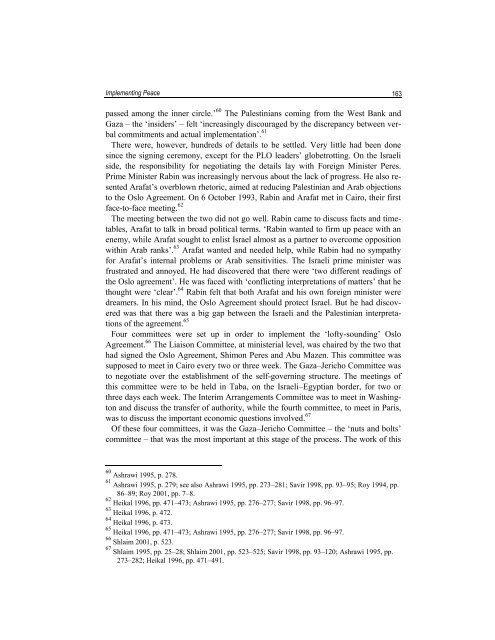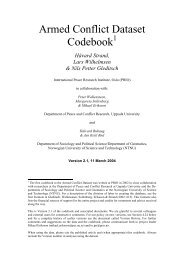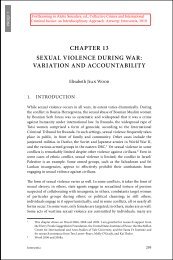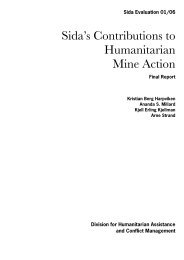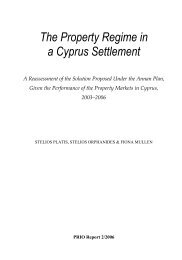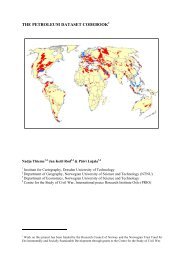Peacemaking Is a Risky Business - PRIO
Peacemaking Is a Risky Business - PRIO
Peacemaking Is a Risky Business - PRIO
You also want an ePaper? Increase the reach of your titles
YUMPU automatically turns print PDFs into web optimized ePapers that Google loves.
Implementing Peace163passed among the inner circle.’ 60 The Palestinians coming from the West Bank andGaza – the ‘insiders’ – felt ‘increasingly discouraged by the discrepancy between verbalcommitments and actual implementation’. 61There were, however, hundreds of details to be settled. Very little had been donesince the signing ceremony, except for the PLO leaders’ globetrotting. On the <strong>Is</strong>raeliside, the responsibility for negotiating the details lay with Foreign Minister Peres.Prime Minister Rabin was increasingly nervous about the lack of progress. He also resentedArafat’s overblown rhetoric, aimed at reducing Palestinian and Arab objectionsto the Oslo Agreement. On 6 October 1993, Rabin and Arafat met in Cairo, their firstface-to-face meeting. 62The meeting between the two did not go well. Rabin came to discuss facts and timetables,Arafat to talk in broad political terms. ‘Rabin wanted to firm up peace with anenemy, while Arafat sought to enlist <strong>Is</strong>rael almost as a partner to overcome oppositionwithin Arab ranks’. 63 Arafat wanted and needed help, while Rabin had no sympathyfor Arafat’s internal problems or Arab sensitivities. The <strong>Is</strong>raeli prime minister wasfrustrated and annoyed. He had discovered that there were ‘two different readings ofthe Oslo agreement’. He was faced with ‘conflicting interpretations of matters’ that hethought were ‘clear’. 64 Rabin felt that both Arafat and his own foreign minister weredreamers. In his mind, the Oslo Agreement should protect <strong>Is</strong>rael. But he had discoveredwas that there was a big gap between the <strong>Is</strong>raeli and the Palestinian interpretationsof the agreement. 65Four committees were set up in order to implement the ‘lofty-sounding’ OsloAgreement. 66 The Liaison Committee, at ministerial level, was chaired by the two thathad signed the Oslo Agreement, Shimon Peres and Abu Mazen. This committee wassupposed to meet in Cairo every two or three week. The Gaza–Jericho Committee wasto negotiate over the establishment of the self-governing structure. The meetings ofthis committee were to be held in Taba, on the <strong>Is</strong>raeli–Egyptian border, for two orthree days each week. The Interim Arrangements Committee was to meet in Washingtonand discuss the transfer of authority, while the fourth committee, to meet in Paris,was to discuss the important economic questions involved. 67Of these four committees, it was the Gaza–Jericho Committee – the ‘nuts and bolts’committee – that was the most important at this stage of the process. The work of this60 Ashrawi 1995, p. 278.61 Ashrawi 1995, p. 279; see also Ashrawi 1995, pp. 273–281; Savir 1998, pp. 93–95; Roy 1994, pp.86–89; Roy 2001, pp. 7–8.62 Heikal 1996, pp. 471–473; Ashrawi 1995, pp. 276–277; Savir 1998, pp. 96–97.63 Heikal 1996, p. 472.64 Heikal 1996, p. 473.65 Heikal 1996, pp. 471–473; Ashrawi 1995, pp. 276–277; Savir 1998, pp. 96–97.66 Shlaim 2001, p. 523.67 Shlaim 1995, pp. 25–28; Shlaim 2001, pp. 523–525; Savir 1998, pp. 93–120; Ashrawi 1995, pp.273–282; Heikal 1996, pp. 471–491.


